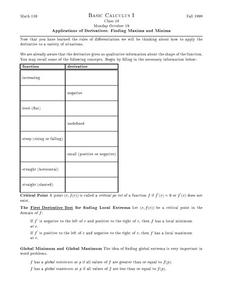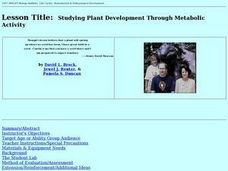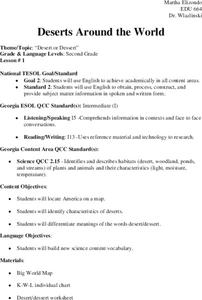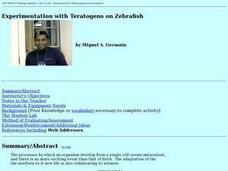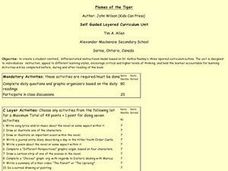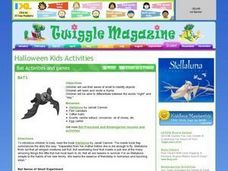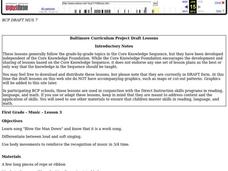Curated OER
Metals and Hydrogen Cars: Chemistry 10-12
Students investigate which metal is best to use as storage material in hydrogen cars. In this chemistry lesson, students differentiate endothermic and exothermic reactions. They write a reflection paragraph about what they learned in the...
Curated OER
Applications of Derivatives: Finding Maxima and Minima
In this calculus worksheet, students are given 10 short-answer problems regarding functions, derivatives, minima, maxima and extremes.
Curated OER
Screaming for Ice Cream
Mathematicians investigate maximizing volume by learning to explore the problem in which they seek to maximize the volume of a cone. Students solve the problem symbolically, graphically, and through the use of integration or...
Curated OER
Triangle Midsegment
Learn how to calculate the length and midsegments of triangles. High schoolers differentiate between similar and congruent triangles. They create a spreadsheet with their findings.
Curated OER
Pythagorean Relationships
Oh that Pythagorean Theorem is so useful. Learners engage in a 45 minute learning activity that requires them to solve for missing angles and sides of a right triangle. They'll use the Pythagorean Theorem to find the rations of sides and...
Curated OER
Troubling Tenses-- Past Simple Vs. Present Continuous 2
In this language arts worksheet, students learn to differentiate between "yesterday" and "tomorrow" by filling in the blanks in 15 sentences with the correct word.
National History Day
“Saving the Bear”: The Russian Expeditionary Force of World War One
How have Russian politics affected countries on a global stage? The discussion of the Russian Revolution and World War I begins with an analysis of primary resource letters. Learners finish with a project where they create a timeline of...
San Antonio Independent School District
Breaking Down the Declaration of Independence
Are learners heavy sighing at the idea of reading a primary source, written in a language that is difficult to understand and in cursive? Look no further, because the resource breaks down the Declaration of Independence in an...
Building Evidence-Based Arguments: Grade 9
High schoolers investigate the dilemma of a proportional response with a lesson about the history of terrorism and militant extremists in the United States. As they examine memos from the FBI and speeches from President Bush and Obama,...
Curated OER
Anti-social Behavior - A Topical Lesson From Learn.co.uk
Students discuss issues of crime, punishment, respect and responsibility,
and explore arguments about causes of crime and possible solutions, and write persuasive essays sharing their views.
Curated OER
What is Money? Learn the Role of Money in a Free Market System
Students view a seashell and listen as the teacher explains that these were sometimes used as money. They listen as the teacher lectures on medium of exchange, barter, and commodity. Students determine the number of chickens it would...
Curated OER
Introduction to Slope Fields
Students plot slope fields. In this introduction to slope fields lesson, students plot 12 slope fields for given differential equations.
Curated OER
Studying Plant Development Through Metabolic Activity
A hands-on activity which allows young scholars to learn about cellular respiration. This lesson contains a range of investigations testing the rates of cellular respiration to demonstrate the relationship between metabolic rates of...
Curated OER
Deserts Around the World
Second graders explore the deserts around the world. They use a map and locate America on the map. Students discuss and identify the characteristics of deserts and differentiate the meanings of the word desert and dessert. Students...
Curated OER
Experimentation with Teratogens on Zebrafish
Students compare mitosis and meiosis with regard to chromosome number in parent cells versus daughter cells, types of cells produced, total number of cells produced, and the number of divisions. In groups, identify and differentiate the...
Curated OER
Flames of the Tiger
Young scholars use the differentiated instructional model based on Dr. Kathie Nunley's three layered curriculum outline. The unit is designed to individualize instruction, appeal to different learning styles, encourage critical and...
Curated OER
Bat Activities and games
First graders read the book Stelluna by Janell Cannon. In this bat lesson plan, 1st graders use their sense of smell to identify objects, learn and recite a rhyme, and differentiate between the words night and day.
Curated OER
Proportional Similarities
Students model the geometric relationship with graphing. In this geometry lesson, students differentiate between parallel, perpendicular, similar and congruent shapes. They use properties of polygons to differentiate their shapes...
Alabama Learning Exchange
Diverse Life Forms of the Ocean
Young scholars recognize marine organisms and differentiate between plankton and nekton. In this investigative instructional activity students create a concept map using their list of terms and study marine life forms.
Curated OER
Graphing Using Cookies
Young scholars differentiate between bar graphs, line graphs, pictographs and bar graphs. After participating in a hands-on cookie activity, students label and draw their own graphs.
Curated OER
Rx Rainforest:
Students identify plant diversity in the rainforest and the role that animals and habitats play in scientific research. They differentiate between natural habitat and laboratory research and work collaboratively to produce a video news...
Curated OER
Music
Third graders learn the song "Blow the Man Down" and know that it is a work song. They differentiate between loud and soft singing. They use body movements to reinforce the recognition of music in 3/4 time.
Curated OER
Prime Numbers and Factors
Students determine factors of numbers to 100 and identify prime factors; students differentiate prime and composite numbers by the factors of the numbers.
Curated OER
Types of Pollution
Students differentiate between various types of water pollution and complete a Venn diagram with the information. They consider why there are laws regulating the release of pollution in water and discuss solutions to pollution problems.

